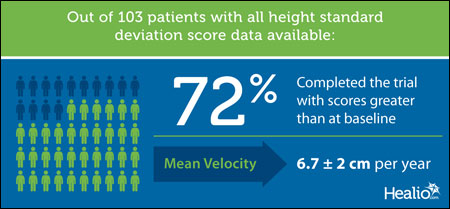Most Tocilizumab-treated Patients With Polyarticular-course JIA Increased in Height
Approximately 72% of adolescent patients at Tanner stage 3 or below who were treated with tocilizumab for polyarticular-course juvenile idiopathic arthritis experienced increased height standard deviation scores at 2 years, according to findings published in the Journal of Rheumatology.
“The effect of chronic arthritis on bone and joint development often results in impaired growth in children, ranging from a mild decrease in growth velocity to severely short stature,” Kamal N. Bharucha, MD, PhD, of Genentech, and colleagues wrote. “Two pivotal phase-3 trials, TENDER18 and CHERISH19, have demonstrated the efficacy of ... tocilizumab in treating the signs and symptoms of systemic JIA and polyarticular-course JIA. A post hoc analysis conducted in the TENDER study population demonstrated that tocilizumab promoted significant catch-up growth in patients with systemic JIA and improvement of laboratory markers associated with growth and bone homeostasis.”
To determine the growth rates of patients with polyarticular-course JIA who are treated with tocilizumab (Actemra, Genentech) over a 2-year period, the researchers conducted a post hoc analysis of the phase 3 CHERISH study. During that trial, 188 patients aged 2 to 17 years — with polyarticular-course JIA lasting at least 6 months and an inadequate response to methotrexate — were treated with open-label, IV tocilizumab every 4 weeks, dosed according to body weight.

After 16 weeks, patients who demonstrated JIA ACR30 responses were randomly selected to receive either tocilizumab or placebo for 24 weeks. Following that, there was an open-label extension through week 104. The researchers calculated mean standard deviation velocity in centimeters per year. In addition, they measured WHO height standard deviation scores among patients treated with one or more dose of tocilizumab who also did not receive any growth hormone, as well as in patients at Tanner stage 3 or below at baseline.
For their post hoc analysis, the researchers focused on 187 of the 188 participants, having excluded one of the patients due to the individual receiving growth hormone. According to the researchers, 123 of these participants were at Tanner stage 3 or below at baseline, of whom 103 had completed the trial with all 104 weeks of height standard deviation score data available. These 103 participants demonstrated increased mean height standard deviation score from baseline to week 104 (+0.40; P < .0001), the researchers wrote. In addition, in 72% of those 103 participants, height standard deviation scores were greater than at baseline, with a mean velocity of 6.7 ± 2 cm per year.
“Most patients with polyarticular-course JIA in the CHERISH study at baseline Tanner stage 3 experienced increased height standard deviation score at the end of year 2, consistent with improved growth profiles previously reported for patients with systemic JIA treated with tocilizumab,” Bharucha and colleagues said. “Overall, patients with polyarticular-course JIA experienced adequate or improved growth over 2 years of treatment with tocilizumab, particularly those whose growth impairment at baseline was greatest.” – by Jason Laday

Disclosure: Bharucha reports employment with Genentech and study funding from F. Hoffmann-La Roche. Please see the study for all other authors’ relevant financial disclosures.
